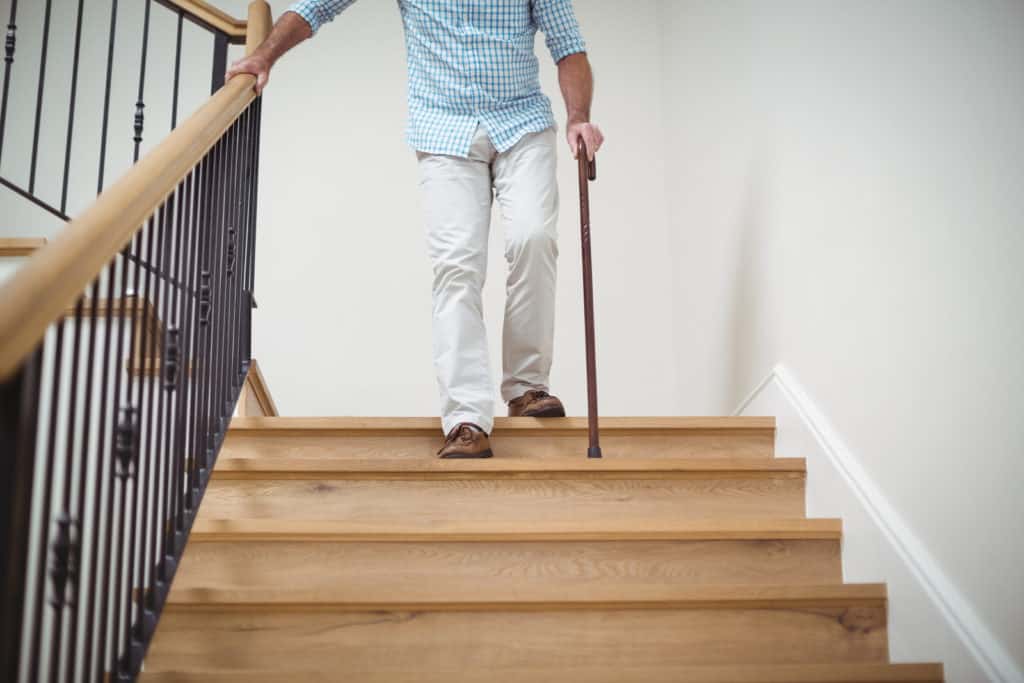
Those who are at risk of falling, like the elderly or some people with disabilities, depend on mobility aids for an improved quality of life, such as walking sticks or canes. If you or a loved one are a part of the population in need of a mobility aid, you might be wondering whether a walking stick or cane is the right choice for you.
Are walking sticks better than canes? While walking canes are designed to be medical devices and have a higher standard of quality, consistency, and safety for those who need a mobility aid for long-term use, the best walking aid is ultimately different for everyone with mobility needs.
Finding the right mobility aid for you or your loved one can dramatically increase the quality of life. There is the right walking aid out there for you or your loved one to feel confident and supported. The remainder of this article will discuss walking sticks and canes in-depth, and provide comparisons between the two types of mobility aids to help you decide which may be better for your specific circumstance.
Walking Sticks vs. Canes: Which is Better?
Every person is going to have their own unique needs for mobility. Knowing a bit more about the difference between walking sticks and canes can help you make an informed choice so that you or your loved one can have more independence and experience more of the world.
What is a Walking Stick?
Walking sticks are not mobility aids, so much as they are accessories or tools. They are meant as a temporary solution for when someone is going to lose their balance during some kind of physical task. They are best used for short term activities where people are going to be walking on uneven terrain like hiking and are not designed to support the user’s weight.
While walking sticks are not designed to be as durable as a walking cane, they tend to be more stylish and can give the user more confidence in their appearance than a walking cane.
What is a Walking Cane?
A walking cane is a medical device that can be covered by insurance and provides mobility support for those who need it on a day-to-day basis. They have the advantage of being available in more varieties than walking sticks.
Types of walking canes include:
- Quad Canes: Quad canes are canes with four prongs at the base so the user can distribute their weight, providing balance and stability.
- Forearm Canes: Forearm canes are canes that support the wearer’s forearm, which relieves pressure on the user’s wrist.
- Adjustable Canes: Adjustable canes can adjust to a variety of heights and sometimes can even fold for easier storage and travel. These features come at the expense of losing some stability.
(Source: Mobility Deck)
Whether or not a walking stick or cane is going to be the best option for someone varies on how they intend to use a mobility aid and what they expect to get out of it. In general, a walking cane is going to have more varieties of designs that offer stability and balance while walking sticks are made more for style and casual physical activities.
While a walking cane is probably the best option for someone who intends to use a mobility aid throughout the day, if you are looking for a walking aid to help you keep balance during outdoor activities where the ground is uneven—like hiking—then your best bet might be a walking stick.
Here is a bit more about the different functions of walking sticks and canes to help you figure out which is right for you:
The Difference Between Walking Sticks and Canes
While there are many similarities between walking sticks and canes, and sometimes are used interchangeably to describe walking aids, there are a few differences between the two that are worth mentioning to help you in your quest to find the perfect mobility aid.
In general, a walking cane is more for medical purposes, whereas a walking stick is more often used to help hikers balance on uneven terrain. Walking canes will vary in design based on different medical needs and functions, whereas walking sticks vary in design for style and for stability on a variety of different terrains, like icy or rocky paths.
Here Are Some Key Differences
The main difference between a walking stick and a walking cane is that a walking stick is not intended to be used as a mobility aid for long term use. A walking cane is designed to give the user long term support and balance. Figuring out which one is right for you is going to come down to what you want your walking aid to do.
While walking canes and sticks are sometimes talked about interchangeably, there are some key differences between the two that are helpful to consider at face value when figuring out which is going to provide the kind of support you need.

- Walking canes are more for medical purposes while walking sticks are used for recreational purposes and are sometimes even an accessory rather than a required aid.
- Walking canes are intended to offer comfortable long-term support, whereas walking sticks can offer stability during activities where someone might be prone to losing their balance, like in hiking.
- Walking canes are usually held and used at the sides, whereas walking sticks are more often held and used in front as you walk.
- Walking canes are often covered by insurance due to their medical application while walking sticks are not.
- Walking canes can have more features and replaceable parts, whereas walking sticks are far less customizable.
Similarities Between Walking Sticks and Canes
While there are some key differences between walking sticks and canes that are going to affect which one is the best choice for you, in general, they serve similar functions such as:
- Giving an elderly or disabled person the confidence to assist themselves with balance issues.
- Improving body posture which can support healthy weight distribution and reduce pain and inflammation in muscles, joints, and the back.
- Reducing the risk of injury from falling by supporting and stabilizing the person using it.
(Source: Greying with Grace)
How to Choose Between a Walking Stick or Cane
People who need mobility assistance are going to want the right walking aid for them. Using the wrong tool for you can cause discomfort and even back pain and injury from falls. Using the right tool correctly, on the other hand, can give the user comfort and a better quality of life. Making sure you identify the right tool for use is crucial.
In order to figure out which walking aid is right for your lifestyle, you will need to know whether or not each device is going to be able to fulfill the purpose that you need it to. You should consider these factors about your circumstance to figure out what device is right for you.
Balance Assistance
If the goal is to take care of a minor balance issue, then a walking stick will suffice. If however balance support is needed throughout the day and you will be more dependent on your mobility aid, then some version of a walking cane will be the better option.
Longevity and Durability
Because walking canes are intended to meet medical standards, they are made to last and hold more weight than a walking stick. If you are looking for support for someone on the heavier side, a cane can be a better choice as it comes in more designs than a cane.
While there are plenty of canes fit for both men and women, keep in mind that because men, on average, weigh more than women and are also taller, they will need a sturdier device that can bear more weight.
Support
If you are looking for something reliable and need a walking aid that is going to support someone with weakness, vertigo, or some other serious long-term medical condition that requires a reliable mobility aid, you should probably look into different cane options.
If you are looking for something that can aid a minor balance or support issue and can improve comfort with short term activities, then a walking stick can be good enough for you.

Materials, Design Elements, and Walking Aids
Everyone has different needs for mobility, and the difference between a walking stick and cane is not necessarily enough to help someone figure out what specific tool you will need.
Both walking sticks and canes can be made from a wide variety of materials, which are going to affect how well the tool works for your intended purpose. Here is an overview of variations in the design of canes and sticks and how they will affect your experience.
Handles
There tend to be noticeable differences in design between sticks and canes when it comes to handles. Figuring out what kind of support you will need from a walking aid’s handle can help you determine which is best for you.
Here are some walking aid handle styles as well as which walking aid is going to have them:
- Knob-handled walking aids are more commonly seen on walking sticks rather than canes as they offer less grip and support for the user. They are more commonly used for appearance or for hiking.
- Palm-shaped handles are wider and have an ergonomic design that forms to the shape of your hand. This increases comfort and security, which can offer more support for the mobility aid user. These are more commonly seen in canes.
- Derby handles are thick handles with a slight curve to fit the natural shape of your palm, which makes them ideal for people who have a difficult time gripping, like arthritis patients. You will see these more on canes.
- The Fritz handle is a variation of the Derby handle. The only difference is it is slightly thinner.
- The offset handle is more of a traditional-looking cane, only rather than the hook of the cane going straight down, it curves back towards the shaft of the cane and distributes weight better than the round curve design. It reduces strain and pressure on the wrists and improves balance. It is most commonly seen in walking canes.
Additionally, you can find places online that will customize your walking stick or cane for your particular needs or style preference. While canes and sticks generally tend to have different handles, not all canes and sticks are going to fit into these categories, as mentioned above.
Looking at the handle of your walking aid can give you an idea of how it will support your weight or balance, regardless of it is a cane or stick.
Different Tips
You will notice that at the end of canes and sticks is a piece of rubber that grips the ground and protects your device by absorbing shock. Different tips are going to have different benefits, but the two you will see most often are:
- Standard Tips: These tips are simple ends on the bottom of your device and can be found on both canes and sticks. These offer less stability than other options but is more convenient and slimmer, allowing for it to fit in narrow spaces.
- Quad Cane Tips: This tip design is actually four prongs at the bottom of your cane, which increases the amount of weight your cane can support as well as offer more balance support. They tend to be more expensive and heavier to move but can be an appropriate choice for someone with limited mobility. They are usually only available in canes rather than sticks.
(Source: Sticks Canes and Walkers)
Material
Consider what material is going to be best for the kind of work you will want to get your device to do. Walking canes and sticks come in wood, metal (usually aluminum), and carbon fiber material.
While wood tends to be cheaper than other options, it can break down over time fast than other materials and are not as good for supporting weight. If you need a cane predominantly for balance, however, this can be a good option for you.
Carbon fiber walking aids are the most costly option but are the most lightweight and sturdy option. Metal devices are also lightweight but are less expensive. These kinds of devices are also usually adjustable.
Height
One aspect of choosing the right mobility aid is to find one that is the right height for you. A cane or stick that is not the right height for you can result in tension and even injury or accidents. Some cane varieties can be adjusted for different heights while walking sticks usually cannot.
To find the right length for you, get a friend to help take your measurements and then:
- Wear the shoes you use most often.
- Stand upright with a relaxed stance.
- Bend the elbow of the hand you intend to hold the can at a 15-20 degree angle.
- Have a friend measure the length between the base of your wrist, which is the joint that connects your wrist and hand, and the ground.
Your cane should be 1-2 inches longer than this measurement in order to achieve the best comfort and support for the user.
A Final Note on Mobility Aids
Some anecdotal evidence suggests that some users can benefit from the limited dependence that they can have on a walking stick, claiming it forces them to use more muscles and naturally maintain strength and posture.
This evidence is not backed up by any scientific claim, but mobility aid users also know their experience and bodies better than anyone else.
It is also worth noting that studies on walking aids usually revolve around canes rather than sticks, and injuries that occur with both walking aids, like increased shoulder tension and worsening arthritis, result not from errors in design elements of the walking aids but in user error.
If you cannot tell which mobility aid is right for you, consider walking around with different options in a safe environment with someone there to assist you in case you lose your balance. Also, make sure you are using your mobility aid correctly to avoid further strain and injury.
Everyone is going to need different mobility needs, listen to your body to see if you need a different kind of support, and take whatever steps you need to be safe as you explore the world with your mobility aid (AAFP).
While everyone who relies on mobility aids to get around, we all have our own unique circumstances that determine what tool will be best for us. Now that you know more about mobility options and how they can make a difference in someone’s life, you can feel empowered to give accessibility and freedom to yourself or your loved one with mobility needs.
References:
https://www.aafp.org/afp/2012/0601/p1018a.html
https://www.grayingwithgrace.com/walking-canes-vs-walking-sticks-differences/
http://stickscanesandwalkers.com/what-is-the-difference-between-a-walking-stick-and-cane/

